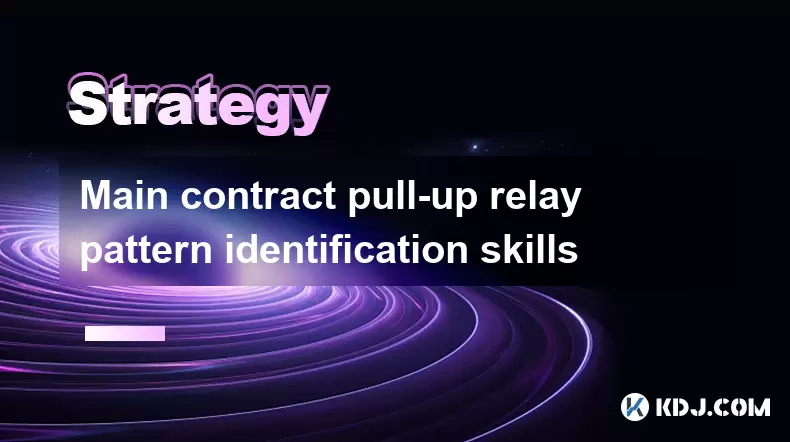-
 bitcoin
bitcoin $122090.672462 USD
1.59% -
 ethereum
ethereum $4493.758974 USD
0.56% -
 xrp
xrp $3.033145 USD
0.65% -
 tether
tether $1.000629 USD
0.00% -
 bnb
bnb $1169.854250 USD
7.07% -
 solana
solana $230.954786 USD
-0.19% -
 usd-coin
usd-coin $0.999785 USD
0.00% -
 dogecoin
dogecoin $0.256108 USD
-1.12% -
 tron
tron $0.342333 USD
-0.12% -
 cardano
cardano $0.859632 USD
-0.10% -
 hyperliquid
hyperliquid $48.932146 USD
-2.25% -
 chainlink
chainlink $22.345466 USD
-1.29% -
 ethena-usde
ethena-usde $1.000217 USD
-0.03% -
 avalanche
avalanche $31.203456 USD
1.93% -
 sui
sui $3.579145 USD
1.05%
Main contract pull-up relay pattern identification skills
Identifying the main contract pull-up relay pattern in crypto trading involves analyzing volume, price movements, open interest, and correlations between contract months.
Jun 05, 2025 at 10:28 am

The main contract pull-up relay pattern is a crucial concept in the cryptocurrency trading world, particularly when dealing with futures and options trading. This pattern involves the strategic shift of trading volume and price movement from one contract to another, typically from a near-month contract to a far-month contract. Identifying this pattern accurately can provide traders with significant insights into market trends and potential trading opportunities. In this article, we will explore the essential skills required to identify the main contract pull-up relay pattern effectively.
Understanding the Main Contract Pull-Up Relay Pattern
The main contract pull-up relay pattern occurs when traders shift their focus from a near-month futures contract to a far-month futures contract. This shift often leads to a noticeable increase in trading volume and price movement in the far-month contract. The key to identifying this pattern lies in observing the volume and price dynamics between different contract months.
Volume Analysis
One of the primary skills needed to identify the main contract pull-up relay pattern is volume analysis. Traders should closely monitor the trading volume of different contract months. When the volume in a far-month contract begins to increase significantly while the volume in the near-month contract starts to decline, it could be an indication of the main contract pull-up relay pattern.
- Monitor trading volumes: Use trading platforms or data analysis tools to track the volume of different futures contracts.
- Compare volumes: Regularly compare the volumes of near-month and far-month contracts to spot any significant shifts.
- Look for trends: Identify trends where the volume in the far-month contract is consistently rising while the near-month contract's volume is falling.
Price Movement Analysis
Another critical skill is price movement analysis. Traders need to observe how the prices of different contract months are moving relative to each other. When the price of the far-month contract starts to rise more aggressively than the near-month contract, it may signal the onset of the main contract pull-up relay pattern.
- Track price changes: Use charting tools to monitor the price movements of different contract months.
- Compare price trends: Analyze the price trends of near-month and far-month contracts to see if the far-month contract is outperforming the near-month contract.
- Identify divergence: Look for instances where the price divergence between the two contracts becomes more pronounced.
Open Interest Analysis
Open interest analysis is also vital in identifying the main contract pull-up relay pattern. Open interest represents the total number of outstanding contracts that have not been settled. An increase in open interest in the far-month contract, coupled with a decrease in the near-month contract, can be a strong indicator of the pattern.
- Monitor open interest: Use trading platforms to track the open interest of different futures contracts.
- Compare open interest levels: Regularly compare the open interest levels of near-month and far-month contracts.
- Analyze changes: Identify changes where the open interest in the far-month contract is increasing while the near-month contract's open interest is decreasing.
Correlation Analysis
Understanding the correlation between different contract months is another skill that can aid in identifying the main contract pull-up relay pattern. Traders should analyze how the performance of one contract month influences the performance of another contract month. A strong positive correlation between the near-month and far-month contracts, followed by a shift where the far-month contract begins to decouple and outperform, can signal the pattern.
- Calculate correlations: Use statistical tools to calculate the correlation between the prices of near-month and far-month contracts.
- Monitor correlation changes: Keep an eye on any changes in the correlation between the two contracts.
- Identify decoupling: Look for signs where the far-month contract starts to decouple and outperform the near-month contract.
Technical Indicators
Utilizing technical indicators can enhance a trader's ability to identify the main contract pull-up relay pattern. Indicators such as the Relative Strength Index (RSI), Moving Averages, and Bollinger Bands can provide additional insights into the strength and direction of the pattern.
- Use RSI: The RSI can help identify overbought or oversold conditions in the far-month contract, which can signal the onset of the pattern.
- Apply Moving Averages: Moving Averages can help smooth out price data and highlight the trend in the far-month contract.
- Employ Bollinger Bands: Bollinger Bands can indicate volatility and potential price breakouts in the far-month contract, which can be indicative of the pattern.
Practical Application
To apply these skills in a practical setting, traders should follow a systematic approach to monitoring and analyzing the market. This involves setting up a trading dashboard that includes real-time data on volume, price, open interest, and technical indicators for both near-month and far-month contracts.
- Set up a trading dashboard: Use trading platforms to create a dashboard that displays real-time data for the relevant futures contracts.
- Regularly update data: Ensure that the data on the dashboard is regularly updated to reflect the latest market conditions.
- Analyze data: Use the skills outlined above to analyze the data and identify any signs of the main contract pull-up relay pattern.
By mastering these skills, traders can enhance their ability to identify the main contract pull-up relay pattern and make more informed trading decisions. This pattern provides valuable insights into market dynamics and can help traders capitalize on emerging trends in the cryptocurrency futures market.
Frequently Asked Questions
Q1: How often does the main contract pull-up relay pattern occur in the cryptocurrency market?The frequency of the main contract pull-up relay pattern can vary depending on market conditions and the specific cryptocurrency being traded. Generally, this pattern is more likely to occur during periods of high market volatility or when significant events are expected to impact the market.
Q2: Can the main contract pull-up relay pattern be used for short-term trading?While the main contract pull-up relay pattern is typically associated with longer-term trends, it can also be used for short-term trading. Traders can look for short-term opportunities within the broader pattern by focusing on the intraday volume and price movements of the far-month contract.
Q3: What are the risks associated with trading based on the main contract pull-up relay pattern?Trading based on the main contract pull-up relay pattern carries several risks, including the potential for false signals, increased volatility in far-month contracts, and the possibility of sudden market reversals. Traders should use risk management strategies, such as stop-loss orders, to mitigate these risks.
Q4: How can traders differentiate between a genuine main contract pull-up relay pattern and a false signal?To differentiate between a genuine main contract pull-up relay pattern and a false signal, traders should look for consistent and sustained changes in volume, price, and open interest over a period of time. Additionally, using multiple technical indicators and correlation analysis can help confirm the validity of the pattern.
Disclaimer:info@kdj.com
The information provided is not trading advice. kdj.com does not assume any responsibility for any investments made based on the information provided in this article. Cryptocurrencies are highly volatile and it is highly recommended that you invest with caution after thorough research!
If you believe that the content used on this website infringes your copyright, please contact us immediately (info@kdj.com) and we will delete it promptly.
- BlockDAG, DOGE, HYPE Sponsorship: Crypto Trends Shaping 2025
- 2025-10-01 00:25:13
- Deutsche Börse and Circle: A StableCoin Adoption Powerhouse in Europe
- 2025-10-01 00:25:13
- BlockDAG's Presale Buzz: Is It the Crypto to Watch in October 2025?
- 2025-10-01 00:30:13
- Bitcoin, Crypto, and IQ: When Genius Meets Digital Gold?
- 2025-10-01 00:30:13
- Stablecoins, American Innovation, and Wallet Tokens: The Next Frontier
- 2025-10-01 00:35:12
- NBU, Coins, and Crypto in Ukraine: A New Yorker's Take
- 2025-10-01 00:45:14
Related knowledge

Practical parameter settings for a Bitcoin multi-timeframe moving average system
Sep 18,2025 at 10:54pm
Optimizing Timeframe Combinations for Bitcoin Trading1. Selecting appropriate timeframes is crucial when building a multi-timeframe moving average sys...

How can I filter out false breakouts in Dogecoin high-frequency trading?
Sep 22,2025 at 01:00am
Understanding False Breakouts in Dogecoin Trading1. A false breakout occurs when Dogecoin's price appears to move beyond a defined support or resistan...

Techniques for identifying tops and bottoms in the Bitcoin on-chain NVT model
Sep 20,2025 at 07:54pm
Understanding the NVT Model in Bitcoin Analysis1. The Network Value to Transactions (NVT) ratio is often described as the 'P/E ratio' of the cryptocur...

What does the surge in open interest in Bitcoincoin futures mean?
Sep 20,2025 at 11:18pm
Understanding the Surge in Dogecoin Futures Open Interest1. A surge in open interest within Dogecoin futures indicates a growing number of active cont...

How can I use the Ethereum USDT premium to gauge market sentiment?
Sep 18,2025 at 11:55pm
Understanding the Ethereum USDT Premium1. The Ethereum USDT premium refers to the price difference between USDT (Tether) traded on Ethereum-based plat...

What should I do if Ethereum staking yields decline?
Sep 20,2025 at 06:18am
Understanding the Causes Behind Declining Ethereum Staking Yields1. The Ethereum network transitioned to a proof-of-stake consensus mechanism with the...

Practical parameter settings for a Bitcoin multi-timeframe moving average system
Sep 18,2025 at 10:54pm
Optimizing Timeframe Combinations for Bitcoin Trading1. Selecting appropriate timeframes is crucial when building a multi-timeframe moving average sys...

How can I filter out false breakouts in Dogecoin high-frequency trading?
Sep 22,2025 at 01:00am
Understanding False Breakouts in Dogecoin Trading1. A false breakout occurs when Dogecoin's price appears to move beyond a defined support or resistan...

Techniques for identifying tops and bottoms in the Bitcoin on-chain NVT model
Sep 20,2025 at 07:54pm
Understanding the NVT Model in Bitcoin Analysis1. The Network Value to Transactions (NVT) ratio is often described as the 'P/E ratio' of the cryptocur...

What does the surge in open interest in Bitcoincoin futures mean?
Sep 20,2025 at 11:18pm
Understanding the Surge in Dogecoin Futures Open Interest1. A surge in open interest within Dogecoin futures indicates a growing number of active cont...

How can I use the Ethereum USDT premium to gauge market sentiment?
Sep 18,2025 at 11:55pm
Understanding the Ethereum USDT Premium1. The Ethereum USDT premium refers to the price difference between USDT (Tether) traded on Ethereum-based plat...

What should I do if Ethereum staking yields decline?
Sep 20,2025 at 06:18am
Understanding the Causes Behind Declining Ethereum Staking Yields1. The Ethereum network transitioned to a proof-of-stake consensus mechanism with the...
See all articles










































































